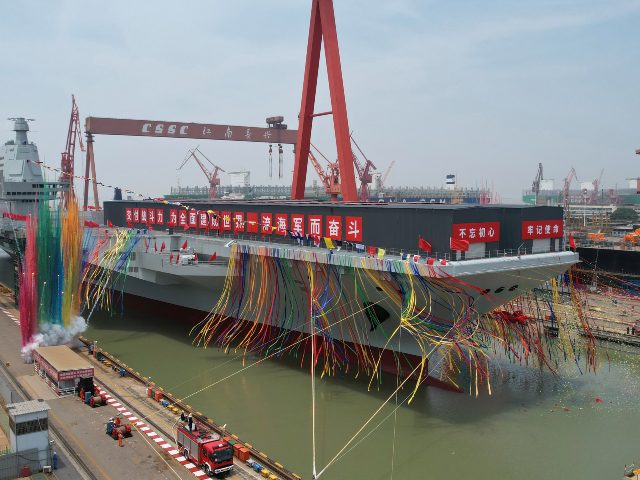China ceremonially launched its third aircraft carrier on Friday and christened it Fujian, the name of the Chinese province opposite the country of Taiwan. The name was clearly meant as a bullying warning to the Taiwanese.
The Fujian was launched from the Jiangnan shipyard in Shanghai, two weeks after rumors that it would be launched during the Dragon Boat Festival holiday on June 3 to boost the morale of the locked-down city.
The carrier evidently was not ready for the Dragon Boat launch, but the People’s Liberation Army Navy (PLAN) masked any embarrassment it might have felt by turning Friday’s launch into a festive event featuring champagne, confetti, and water cannon salutes.
The naming ceremony was overseen by Xu Qilang, vice chair of the all-powerful Central Military Commission, but somewhat curiously not by the chairman, Chinese dictator Xi Jinping.
Xi is instead hosting the annual BRICS summit today. The annual meeting of Brazil, Russia, India, China, and South Africa has been held virtually ever since the Wuhan coronavirus pandemic began.
A senior Taiwanese official told Reuters the belligerent message sent by the Fujian’s naming ceremony has been received in Taipei – and in Tokyo.
“In the future, they want to directly penetrate to the east of the first island chain, which includes Japan’s Ryukyu Islands and the Pacific waters off Taiwan’s east,” the Taiwanese official said.
“Any regional cooperation is seen by Beijing as an intervention in the Taiwan issue or a challenge to China. The launch of the new carrier is a defiant statement,” the official declared.
The Taiwanese Defense Ministry’s official statement on the carrier launch said it was an event of “great importance,” and China’s third aircraft carrier would be duly incorporated into Taiwan’s defense strategy.
Chinese state media boasted that Fujian is a major advance beyond China’s first two carriers, the archaic retrofitted Russian carrier Liaoning and the domestically-built Shandong. Unlike those ships, whose flight decks end in “ski jump” ramps, the Fujian allegedly has a vastly superior catapult system for launching planes, similar to the launch system on American carriers.
The Fujian is much smaller and less sophisticated than any of America’s 11 operational carriers, displacing 80,000 tons compared to over 100,000 tons for the U.S. Nimitz-class carrier and the next-generation Gerald R. Ford class.
The Fujian will soon begin years of sea trials; the PLAN has not yet announced a date when the carrier will become operational. The Liaoning is primarily a training vessel, while the Shandong held ostentatious fighter and helicopter launch drills east of Okinawa in December to show off its combat capability.
Analysts at the International Institute for Strategic Studies (IISS) said the Fujian’s launch nevertheless represents “a further step-change in the long-range power-projection capability of the People’s Liberation Army Navy over and above the potential offered by the first two carriers.”
One key point made by IISS is that China leapfrogged past the steam catapult system employed by the older American carriers and went right to an electromagnetic system, similar to the one used by the Gerald R. Ford class. This launcher makes the carrier capable of carrying a much wider variety of fighters, bombers, and surveillance craft.
The smaller Fujian has only three catapults compared to the four on American carriers, and it is not nuclear-powered, so its range and strike capability will be more limited. IISS predicted China’s next carrier will be nuclear-powered, and much closer to American carriers in size. The PLAN aspires to have six carriers in the water by the end of the next decade.

COMMENTS
Please let us know if you're having issues with commenting.